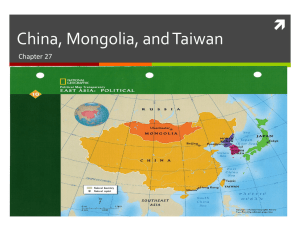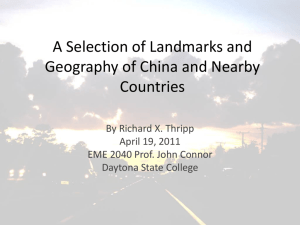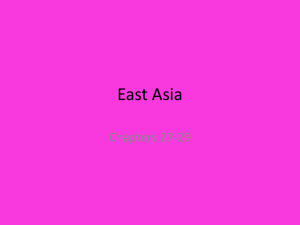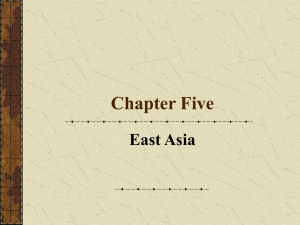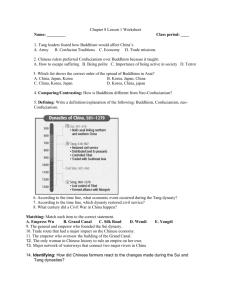History of Countries in East Asia PPT
advertisement
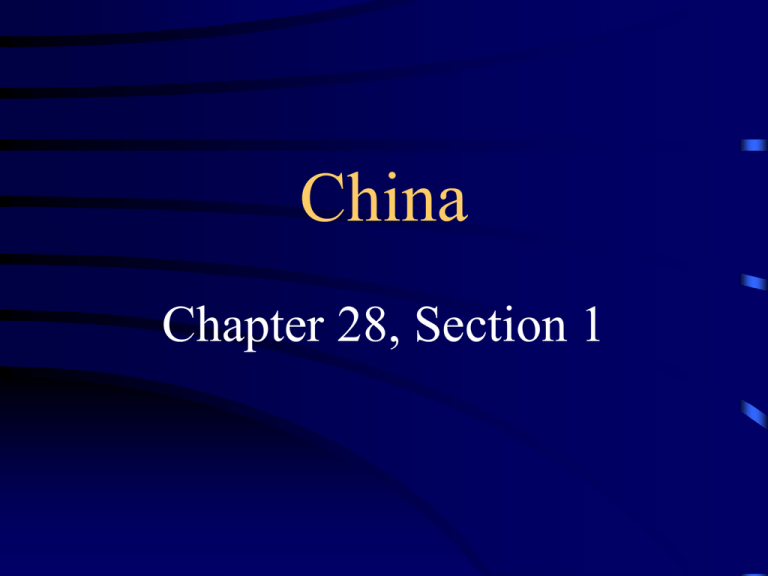
China Chapter 28, Section 1 China Early History • Early China was not influenced by other countries due to the geography and long distances • Dynasty- a series of rulers from the same family • 1st Chinese dynasty was Shang which arose in 1700 b.c.- ruled for over 600 years China Early History • Qin Dynasty, pronounced Chihn, gave its name to China • 1st Qin emperor, Shi Huangdi, began the building of the Great Wall in 220 b.c. • This dynasty ruled for over 2000 years. • Han Dynasty • Manchurians invaded and established the Qing Dynasty • 1911- Revolutionary war ended the rule of dynasty’s China Early History • Boxer Rebellion- Chinese militants attacked Europeans and Chinese Christians trying to break free from the influence on the Europeans that were trying to take advantage of the Chinese military and government weakness • 1949- Communist fought for control over China and won…Mao Zedong became the new ruler China Early History • Due to the involvement of government in the economy, China is now one of the fastest growing economies in the world. • 60% of population work on farms • Known for its rice, maize, wheat, and sweet potatoes Major Religions of China • Confucianism- based on teaching of Confucianism, stresses importance of education in a well-run society • Taoism- based on teaching of Lao-tzu, importance of preserving and restoring harmony in the individual as well as the universe- also believed gov’t should have little to do with the people • Buddhism- believe in rebirth and is highly influenced by Confucianism and Taoism Population • China estimated population in 2000 was 1.3 billion. • 30-40 cities have a population over 1 million • China’s government has pursued a strategy in order to provide healthcare to its entire population Mongolia and Taiwan Chapter 28, Section 2 The Mongolian Empire • Mongols were nomadic herders for thousands of years The Mongolian Empire • Genghis Khan –Conquered all of Central Asia –Began conquest of China –Died in 1227 The Mongolian Empire • Ogadai –Succeeded Genghis Khan –Continued conquest and expansion The Mongolian Empire • Broke up in 1300s • China gained control of Mongolia in 17th century • Mongolia achieved independence in 1911 Mongolia • Became the Mongolian People’s Republic in 1924 • Communists ruled until 1989 • Moved toward political democracy and free enterprise economy Mongolia • Culture –Has ruled and been ruled by China –Adopted many aspects of Chinese culture Mongolia • Economy –Herding and managing livestock –Developing other industries –Shift from command to free economy Mongolia • Economy –Large deposits of coal and petroleum •Used in manufacturing and construction Taiwan’s Link to China • Many migrations from southern China, southeast Asia, Malay and Polynesia • Manchu Dynasty conquered Taiwan in 1683 Taiwan’s Link to China • Japanese seized Taiwan after winning a war with China in 1895 • Chinese Nationalists took control as part of their fight with the Communists after WWII Taiwan’s Link to China • Nationalists lost to Communists in 1949 –Moved their gvt to Taiwan –Est. Republic of China –People’s Republic of China never recognized Taiwan as a separate country Taiwan • Culture –Chinese –90% practice mix of Buddhism, Confucianism, and Taoism Taiwan • Economy –One of world’s most successful economies –Strong manufacturing industries –Good trade Taiwan • Economy –Known as an economic tiger, a nation that has rapid economic growth due to cheap labor, high technology, and aggressive exports Taiwan • Economy –Part of the Pacific Rim, which includes East Asia, Southeast Asia, Australia, New Zealand, Chile and west coast of the U.S. THE KOREA’S Chapter 28, Section 3 History of Korea • Korea is a peninsula • 2000 b.c. first state called Chosen arose in Korea • 100 b.c. China and Japan begin their history of invasions due to its location between the two countries History of Korea • 300’s- Three Kingdoms were established, Koguryo, Paekche, and Silla. • Sills eventually took over the other two kingdoms in 660. • 1392- Yi Songgye and dynasty ruled Korea but ended in 1910 when Japan took over • Japan controlled peninsula until 1945 and the end of WWII History of Korea • After WWII, Korea was split in two, North controlled by the Soviet Union and the South controlled by the United States • 1950- North invaded South to spread communism and started the Korean War • 1953- War ended and treaty was created to split the North into a Communist State and the South into a Democratic State Korean Culture/Unity • Chinese influence- Confucianism, Buddhism, Communism • Unity- North and South are trying to unify • Both built huge armies, bordered by 2 million troops • Unified by one flag representing both countries Resources • Seoul- largest city in South Korea • Pyongyang- largest city in North Korea • When countries unite, they will be a economic powerhouse • North provide raw materials for South industry Japan Chapter 28, Section 4 Samurai/Shogun • Samurai-Professional soldiers serve as bodyguards for landowners and clan chiefs • Shogun-General of emperors army with powers of military dictator • All officials are under authority of Shogun History/Economy • December 7, 1941- Japan bombs Pearl Harbor • August 9, 1945- Nagasaki and HiroshimaU.S. dropped bombs • After WWII, Japan became one of the worlds most powerful economy • 126 million people in Japan • 75% live in cities Economy • Most of population on east coast, industry and manufacturing • Cars, Trucks, and Electronic equipment • Strong alliance between business and government • People of Japan are educated and disciplined which enabled Japan to achieve prosperity
